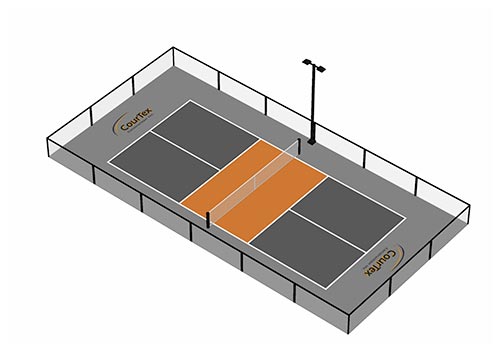Inexpensive Pickleball Court Construction for Homes and Communities
Inexpensive Pickleball Court Construction for Homes and Communities
Blog Article
Lasting Practices in Pickleball Court Construction You Ought To Know
As the popularity of pickleball continues to increase, so also does the requirement for lasting practices in court building and construction. The effect of these techniques extends much past the court itself.
Choosing Eco-Friendly Materials
Picking green materials is a crucial action in the building of sustainable pickleball courts. The option of lasting products not only minimizes environmental impact yet additionally enhances the long life and performance of the court. Secret products consist of reused rubber for the surface area, which provides excellent toughness and shock absorption while drawing away waste from landfills.
In addition, utilizing locally sourced products decreases transportation exhausts and supports regional economies. Pickleball court construction. For instance, using indigenous hardwoods for fence and seating can give a lasting aesthetic while ensuring strength versus the aspects.
Incorporating absorptive materials for court foundations can even more add to sustainability by enabling for natural water drain and lowering runoff. These choices not just safeguard neighborhood ecosystems but likewise promote much healthier play environments.
Effective Water Drainage Solutions
While the selection of environment-friendly products is necessary, executing reliable water drainage options is similarly essential for keeping sustainable pickleball courts. Proper drainage not only safeguards the court surface from water damages yet additionally minimizes disintegration and drainage, advertising environmental stability.
Reliable drain systems can include permeable paving, which allows water to penetrate the ground instead of pooling externally. This decreases the chance of standing water, which can lead to mold and mildew and various other upkeep concerns. In addition, including tactically placed water drainage channels and swales can direct excess water away from the court location, making sure a dry playing surface and avoiding soil disintegration.
Using indigenous plants in the landscape design around the courts can further boost drainage by taking in excess water and reducing runoff. These plants need much less irrigation and advertise biodiversity, aligning with sustainable techniques.
In addition, it is crucial to regularly preserve the drain system to guarantee its lasting effectiveness. This includes clearing up particles and tracking for obstructions. By prioritizing reliable water drainage services, pickleball court producers can significantly add to the sustainability and durability of the facility, eventually profiting both gamers and the setting.
Energy-Efficient Illumination Options
As the need for pickleball remains to grow, integrating energy-efficient illumination choices right into court design has become progressively crucial for sustainability. Standard illumination systems frequently consume excessive power, adding to greater operational costs and ecological effect. As a result, adopting modern, energy-efficient technologies is important for both new constructions and renovations.
LED (Light Emitting Diode) lights sticks out as a leading selection because of its long life and energy financial savings (Pickleball court construction). Compared to standard lighting, LEDs utilize approximately 75% much less energy and can last approximately 25 times longer, dramatically minimizing maintenance costs. The directional nature of LED lighting lessens light pollution, guaranteeing that illumination is concentrated on the court instead than bordering locations.

Lasting Surface Area Alternatives
Exploring sustainable surface options for pickleball courts has actually gained traction among contractors and players alike. The emphasis on eco-friendly materials not only aligns with the expanding ecological recognition yet likewise improves the performance and resilience of the courts.
This material supplies excellent shock absorption, minimizing the risk of injuries for gamers while promoting sustainability. These ceramic tiles are very easy to set up and change, and their flexibility allows for various court arrangements.
All-natural turf courts are likewise becoming a lasting option, advertising biodiversity and lowering the heat island effect. They require regular maintenance and water, which may not align with all sustainability goals.

Water Preservation Techniques

Another reliable technique includes the installation of rain harvesting systems. These systems store and accumulate rain for use in maintaining court surfaces and landscape design. This approach not just conserves drinkable water however additionally reduces dependence on metropolitan sources.
Additionally, employing drought-resistant landscaping around the courts is essential. Native plants require less water and are better adapted to regional climate conditions, therefore reducing general water intake. In addition, utilizing efficient irrigation systems, such as drip irrigation, guarantees that water is delivered directly to plant roots, lessening evaporation and waste.
Final Thought
Incorporating sustainable methods in pickleball court building and basics construction dramatically adds to ecological preservation and source effectiveness. Using green products, carrying out efficient water drainage services, and embracing energy-efficient lights alternatives can considerably minimize eco-friendly effect. Furthermore, discovering lasting surface area options and employing water preservation strategies enhance the total sustainability of these recreational facilities - Pickleball court construction. By prioritizing these techniques, the building of pickleball courts can line up with more comprehensive environmental goals while advertising durability and capability within communities.
As the appeal of pickleball proceeds to climb, so also does the demand for lasting techniques in court building and construction.Picking eco-friendly materials advice is a crucial action in the building of sustainable pickleball courts. By prioritizing energy-efficient lighting alternatives, pickleball court fitters can contribute to a more lasting future while fulfilling the needs of stakeholders and gamers alike.Integrating sustainable surface area options not only boosts the performance of pickleball courts but also paves the means for executing efficient water preservation methods.Integrating sustainable techniques in pickleball court building significantly adds to environmental conservation and resource efficiency.
Report this page